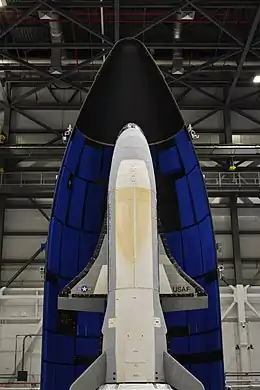USA-299
USA-299, also referred to as Orbital Test Vehicle 6 (OTV-6), is the third flight of the first Boeing X-37B, an American unmanned vertical-takeoff, horizontal-landing spaceplane. It was launched to low Earth orbit aboard an Atlas V rocket from SLC-41 on May 17, 2020 and remains in orbit. Its mission designation is part of the USA series.
 OTV-6 prior to encapsulation in the fairing | |
| Mission type | Classified |
|---|---|
| Operator | U.S. Space Force |
| COSPAR ID | 2020-029A |
| SATCAT no. | 45606 |
| Mission duration | 8 months and 18 days |
| Spacecraft properties | |
| Spacecraft type | Boeing X-37B |
| Manufacturer | Boeing |
| Launch mass | 5,400 kg (11,900 lb)[1] |
| Power | Deployable solar array, batteries[1] |
| Start of mission | |
| Launch date | 17 May 2020 |
| Rocket | Atlas V |
| Launch site | SLC-41 |
| Contractor | United Launch Alliance |
| End of mission | |
| Landing site | TBD |
| Orbital parameters | |
| Reference system | Geocentric |
| Regime | Low Earth |
| Perigee altitude | 388 km (241 mi) |
| Apogee altitude | 404 km (251 mi) |
| Inclination | 44.6 degrees |
The spaceplane is operated by the United States Space Force, which considers the mission classified and as such has not revealed the objectives. However an unclassified secondary satellite, FalconSat-8, was deployed from the X-37B soon after launch.[2]
Mission
OTV-6 is the third mission for the first X-37B built, and the sixth X-37B mission overall. It flew on an Atlas V in the 501 configuration, and launched from Cape Canaveral Space Launch Complex 41.[3]
OTV-6 was deployed into an orbit with an inclination of approximately 44.6°.[4]
OTV-6 remains in orbit as of September 2020.
FalconSat-8
A rideshare payload for the United States Air Force Academy, FalconSat-8, was deployed from the X-37B a few days into the mission. The satellite provides a platform for the Air Force Cadet Space Operations Squadron to test various technologies.
Onboard experiments include:
- MEP (Magnetic gradient Electrostatic Plasma thruster), a novel electromagnetic propulsion system
- MMA (MetaMaterials Antenna), a low power, high performance antenna
- CANOE (CArbon NanOtubes Experiment)
- ACES (Attitude Control and Energy Storage), a commercial reaction wheel modified into a flywheel
- SkyPad, off-the-shelf cameras and GPUs integrated into a low power package
References
- Krebs, Gunter D. "X-37B OTV 1, 2, 3". Gunter's Space Page. Retrieved 10 July 2013.
- "FalconSat 8". Gunter's Space Page. Retrieved 18 September 2020.
- Graham, William (16 May 2020). "ULA Atlas V launches sixth mission for X-37B spaceplane". NASASpaceFlight.com. Retrieved 18 September 2020.
- "OTV-6 Launch". www.zarya.info. Retrieved 18 September 2020.
